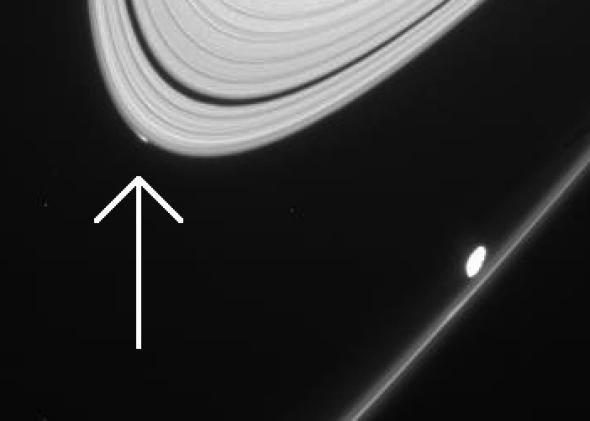Just when I think Saturn can’t surprise me any more: The Cassini spacecraft may have taken the birth pictures of a new moon! It may have also spotted its demise. Or maybe part of its demise. Also, it may be twins.
OK, let me explain.
The potential moon (nicknamed Peggy) is tiny, probably only about a kilometer (0.6 miles) across—really a moonlet—and is invisible in the Cassini pictures. However, its presence is betrayed by an odd clumping of material at the very edge of Saturn’s A ring, the outermost of Saturn’s main rings.
It was discovered by accident in an image taken on April 15, 2013—one year ago today. The picture above shows the main rings, the thin F ring outside them, and the irregularly shaped moon Prometheus (the actual target of the shot) in the center just inside the F ring. If you look carefully you can see a blob on the edge of the A ring. Here’s a close-up, with the clump indicated:
That’s clearly not a discrete object; it’s about 10 kilometers (6 miles) wide and 1,200 kilometers (740 miles) long, but this is what you would expect if a small object were located near the edge of the ring—and why astronomers think there’s most likely a moonlet there. It would have feeble gravity, but enough to affect the ice particles in the ring, creating the long, trailing clump.

Photo by NASA/JPL/Space Science Institute
Once they knew it was there, the astronomers were able to calculate an orbit for it, and then go back and look for it in older Cassini images. They found the clump in more than 100 such pictures! But in most cases it’s so faint and difficult to see that it was completely overlooked before. It appears brighter at certain viewing angles, which is why it was so obvious in the discovery image. The earliest it was seen was in May 2012, but before then Cassini was not in a good orbit to detect the clump, so there’s no way to really know how old it is.
But then things get weirder. In images taken before January 2013 there’s only a single object, but in later images, just around the time the object was discovered, a second one appeared! They’re obviously related, but it’s not clear whether the main object broke up due to a collision with something else, or whether Saturn’s tides (the change in the force of gravity over distance) pulled it apart. It may also be due to some other mechanism entirely.
I dug up another of the images showing the clumps, taken on June 22, 2013:

Photo by NASA/JPL/Space Science Institute
I’ve indicated their locations; you can just see a gap between them and the main A ring. Once I knew what to look for they were obvious, but I can see why they could’ve been missed before. They’re hard to spot. I’ll note that in other images they found what may be a third object as well, but it’s difficult to know what its relationship is to the other two (if any).
And we’re still not done. Not long after the discovery image, Object 2 disappeared! Due to complex interactions with the ring particles, an object the size of the small moon can migrate outward, away from Saturn, over time. Once it leaves the rings it would become essentially invisible. An alternate explanation is that it disintegrated; if its orbit was a bit eccentric, a bit stretched, compared to the particles in the rings it would have been continually bombarded by them, and could have been obliterated.
Still, it was there, at least for a while. And the other object may have survived as well.
So I suppose congratulations are in order for Saturn on its possible new moon … but it’s funny. Saturn is the Roman name for the Greek god Cronus (or Cronos), who was known for eating all his children to prevent them from overthrowing him (when you get down to it, a lot of the ancient myths are really, really horrid). But now we find out the opposite is true! The smaller moons may have been birthed by Saturn (or at least, its rings) and moved out before they could get eaten.
Science! I’ll take it over myth any day.
